尼可地尔注射液药品说明书(英文)
丁咯地尔使用说明
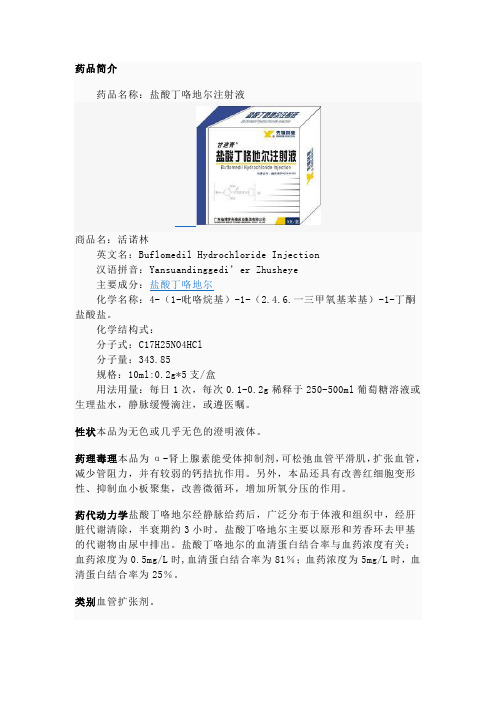
药品简介药品名称:盐酸丁咯地尔注射液商品名:活诺林英文名:Buflomedil Hydrochloride Injection汉语拼音:Yansuandinggedi’er Zhusheye主要成分:盐酸丁咯地尔化学名称:4-(1-吡咯烷基)-1-(2.4.6.一三甲氧基苯基)-1-丁酮盐酸盐。
化学结构式:分子式:C17H25NO4HCl分子量:343.85规格:10ml:0.2g*5支/盒用法用量:每日1次,每次0.1-0.2g稀释于250-500ml葡萄糖溶液或生理盐水,静脉缓慢滴注,或遵医嘱。
性状本品为无色或几乎无色的澄明液体。
药理毒理本品为α-肾上腺素能受体抑制剂,可松弛血管平滑肌,扩张血管,减少管阻力,并有较弱的钙拮抗作用。
另外,本品还具有改善红细胞变形性、抑制血小板聚集,改善微循环,增加所氧分压的作用。
药代动力学盐酸丁咯地尔经静脉给药后,广泛分布于体液和组织中,经肝脏代谢清除,半衰期约3小时。
盐酸丁咯地尔主要以原形和芳香环去甲基的代谢物由尿中排出。
盐酸丁咯地尔的血清蛋白结合率与血药浓度有关;血药浓度为0.5mg/L时,血清蛋白结合率为81%;血药浓度为5mg/L时,血清蛋白结合率为25%。
类别血管扩张剂。
适应症1.周血管疾病:间歇性跛行、雷诺综合症,Burger综合征、血管性痉挛。
2.血管疾病:血管性痴呆。
用量用法:片剂 300-600mg/日,分2次口服,注射液肌肉注射:50mg tid,14日为一疗程。
静脉注射:50-400mg/日,10日为一疗程。
鉴别1.取本品适量,加水制成每1ml中约含盐酸丁咯地尔25μg的溶液,照分光光度法(中国药典2000年版二部附录Ⅳ A)测定,在282nm的波长处有最大吸收,在249nm的波长处有最小吸收。
2.在含量测定项下记录的色谱图中,供试品主峰的保留时间应与对照品主峰的保留时间一致。
检查pH值应为5.0-7.0(中国药典2000年版二部附录Ⅵ H)。
尼可地尔

分类号:学校代码:10438密级:学号:2010044硕士学位论文题目尼可地尔、硝酸甘油治疗冠心病急性心力衰竭临床观察研究及分析院、系(所)临床学院专业内科学学位类型医学专业学位研究生徐国豪导师王健教授论文起止日期: 2013年10月-2014年03月尼可地尔、硝酸甘油治疗冠心病急性心力衰竭临床观察研究及分析徐国豪研究生:内科学专业:导王健教授师:中文摘要1.目的:探讨冠心病急性心力衰竭患者应用尼可地尔、硝酸甘油治疗前后NT-proBNP、CTnl及LV、LVEF、LVEDV, LVESV、E/A的差异。
通过以上指标的变化评价尼可地尔、硝酸甘油对冠心病急性心力衰竭患者的治疗效果。
2.方法:选择2012. 01-2013. 08青岛莱西市人民医院收治的48例冠心病急性心力衰竭患者, 所有患者随机分为尼可地尔组和硝酸甘油组,两组在入院后均均针对病情加用对应的其他药物治疗,包括抗血小板凝集药物、利尿药物、强心药物、降压药物、调脂药物,尼可地尔组(n=24)入院后给予静脉滴注尼可地尔治疗,硝酸甘油组(n=24)则给予静脉滴注硝酸甘油治疗。
治疗前和治疗后第5天分别抽取静脉血检测NT-proBNP和心脏肌钙蛋白I (cTnl)水平并在两组之间进行比较。
两组患者均行心脏彩色多普勒超声检查,计算并比较LV、LVEF、LVEDV, LVESV、E/A的差异。
用SPSS 17.0进行统计分析。
3.结果:3.1尼可地尔组、硝酸甘油组治疗前一般临床资料经均数比较及卡方检验后,两组研究对象在危险因素、性别、年龄以及致病因素之间比较,差异无统计学意义(P>0. 05)。
3.2两组治疗前NT-proBNP差异无统计学意义(P〉0.05);治疗后NT-proBNP指标均明显降低,与治疗前比较,有统计学意义,且尼可地尔组效果更佳(P<0.05)。
3.4治疗前27.0%的患者cTnl升高,其中尼可地尔组8例, 硝酸甘油组5例,两组间差异组效果更佳(P<0.05)。
盐酸丁咯地尔注射液说明书
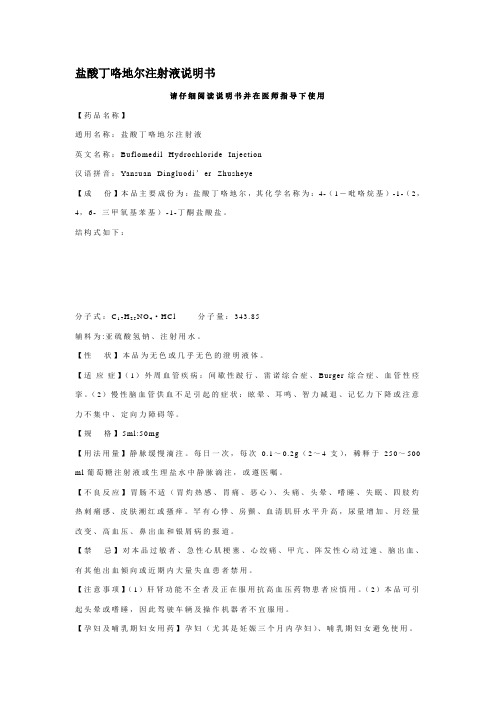
盐酸丁咯地尔注射液说明书请仔细阅读说明书并在医师指导下使用【药品名称】通用名称:盐酸丁咯地尔注射液英文名称:Bu flo medil Hydrochlo ride Injection汉语拼音:Yansu an Din gluodi’er Zhusheye【成份】本品主要成份为:盐酸丁咯地尔,其化学名称为:4-(1-吡咯烷基)-1-(2,4,6- 三甲氧基苯基)-1-丁酮盐酸盐。
结构式如下:H25NO4·HCl分子量:343.85分子式:C17辅料为:亚硫酸氢钠、注射用水。
【性状】本品为无色或几乎无色的澄明液体。
【适应症】(1)外周血管疾病:间歇性跛行、雷诺综合症、Burger综合症、血管性痉挛。
(2)慢性脑血管供血不足引起的症状:眩晕、耳鸣、智力减退、记忆力下降或注意力不集中、定向力障碍等。
【规格】5ml:50mg【用法用量】静脉缓慢滴注。
每日一次,每次0.1~0.2g(2~4支),稀释于250~500 ml葡萄糖注射液或生理盐水中静脉滴注,或遵医嘱。
【不良反应】胃肠不适(胃灼热感、胃痛、恶心)、头痛、头晕、嗜睡、失眠、四肢灼热刺痛感、皮肤潮红或搔痒。
罕有心悸、房颤、血清肌肝水平升高,尿量增加、月经量改变、高血压、鼻出血和银屑病的报道。
【禁忌】对本品过敏者、急性心肌梗塞、心绞痛、甲亢、阵发性心动过速、脑出血、有其他出血倾向或近期内大量失血患者禁用。
【注意事项】(1)肝肾功能不全者及正在服用抗高血压药物患者应慎用。
(2)本品可引起头晕或嗜睡,因此驾驶车辆及操作机器者不宜服用。
【孕妇及哺乳期妇女用药】孕妇(尤其是妊娠三个月内孕妇)、哺乳期妇女避免使用。
【儿童用药】儿童避免使用。
【老年用药】老年患者在肝脏代谢减慢,通过肾脏、粪便排泄率减慢,应酌情减量。
【药物相互作用】与降血压药物合用时可能引起血压过度降低,应注意。
【药物过量】药物过量可引起严重低血压、心动过速及抽搐等,应及时对症治疗。
【药理毒理】本品为α-肾上腺素受体拮抗剂,可松弛血管平滑肌、扩张血管,减少血管阻力,并有较弱的钙拮抗作用。
药物化学—心脑血管用药共20页

口服。开始剂量为早晨5毫克 (一粒)。盐酸司来吉兰胶囊 剂量可增至每天10毫克(二粒) (早晨一次服用或分早、中2次 服用)。
若病人在合用左旋多巴制剂时 显示类似左旋多巴的不良反应, 左旋多巴剂量应减低。或遵医 嘱。
小结
关注心脑健康 珍爱生命
药理毒性试验及临床试验等项研究工作。并达到实用阶段 1984年初在日本上市。目前市场上销售的烟浪丁商品名称包括:Ikorel
(在英国,澳大利亚和欧洲大部分地区), Dancor (瑞士) , Zynicor (在印度) , Aprior (菲律宾)和Sigmart (在日本,韩国和 台湾)
尼可地尔作用机理
心脑血管用药简述
抗心绞痛药物-尼可地尔 抗帕金森病药物-司来吉兰
小结
一尼可地尔简介
尼可地尔别名烟浪丁,硝烟酯, SIGMART,PERISALOL,化学名硝酸乙 氧烟酰胺,属硝酸酯类化合物,英文 名:Nicorand
图片
尼可地尔(喜格迈R)是首个用于临床 的ATP敏感的钾离子通道开放剂,临床 研究证实,它适用于各类型心绞痛, 包括劳力型心绞痛和痉挛性心绞痛, 而且能显著减少心血管事件发生风险, 改善预后。尼可地尔的上市将成为心 绞痛患者的新选择
结构式: 分子式:C13H17N·HCl
作用机理
盐酸司来吉兰片能抑制单胺氧 化酶B(MAO-B)的活性,减少内 源性与外源性多巴胺的降解, 相对增加脑内多巴胺含量,延 长外源性多巴胺作用时间,减 少血药浓度波动,增强多巴类 药物疗效;同时可抑制突触前 膜对多巴胺的重摄取作用,间 接增加多巴胺含量
减少因MAO-B活性增高导致体内 多巴胺降解产生大量自由基, 造成对多巴胺能神经元的损伤, 减缓多巴胺能神经元的变性、 死亡,从而有效保护多巴胺能 神经元,延缓帕金森病发展
卡舒泰(盐酸尼卡地平葡萄糖注射液)
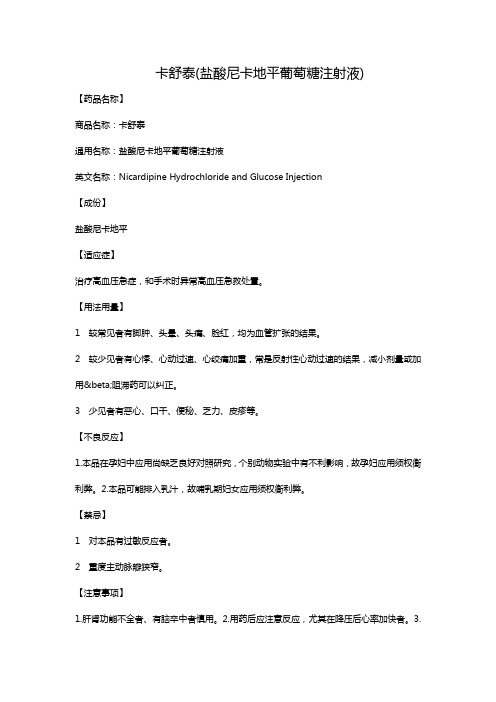
卡舒泰(盐酸尼卡地平葡萄糖注射液)【药品名称】商品名称:卡舒泰通用名称:盐酸尼卡地平葡萄糖注射液英文名称:Nicardipine Hydrochloride and Glucose Injection【成份】盐酸尼卡地平【适应症】治疗高血压急症,和手术时异常高血压急救处置。
【用法用量】1 较常见者有脚肿、头晕、头痛、脸红,均为血管扩张的结果。
2 较少见者有心悸、心动过速、心绞痛加重,常是反射性心动过速的结果,减小剂量或加用β阻滞药可以纠正。
3 少见者有恶心、口干、便秘、乏力、皮疹等。
【不良反应】1.本品在孕妇中应用尚缺乏良好对照研究,个别动物实验中有不利影响,故孕妇应用须权衡利弊。
2.本品可能排入乳汁,故哺乳期妇女应用须权衡利弊。
【禁忌】1 对本品有过敏反应者。
2 重度主动脉瓣狭窄。
【注意事项】1.肝肾功能不全者、有脑卒中者慎用。
2.用药后应注意反应,尤其在降压后心率加快者。
3.本品也曾用于充血性心力衰竭,初步结果见后负荷减低而不影响心肌收缩力,但须注意本品的负性肌力作用。
4.本品可能减低脑血管阻力,增加肾小球滤过率。
5.若注射部位出现疼痛或发红时,应改变注射部位。
【特殊人群用药】儿童注意事项:本品在儿童中应用的安全性尚缺少研究。
妊娠与哺乳期注意事项:1.本品在孕妇中应用尚缺乏良好对照研究,个别动物实验中有不利影响,故孕妇应用须权衡利弊。
2.本品可能排入乳汁,故哺乳期妇女应用须权衡利弊。
老人注意事项:本品在老年人与中青年人中的药动学研究未发现差异,故老年人应用与中青年人同。
老年人用本品,宜从低剂量(0.5μg/(kg·min))开始。
【药物相互作用】1 本品与β阻滞剂合用,耐受良好。
2 本品与西咪替丁合用,本品血药浓度增高。
3 本品与地高辛合用,未见到地高辛血药浓度增高,但须测定地高辛血药浓度。
4 本品与环孢素合用时,环孢素血药浓度增高。
5 在体外,治疗浓度的呋塞米、普萘洛尔、双嘧达莫、华法林、奎尼丁、萘普生加于人体血浆中,不改变本品的蛋白结合率。
心力衰竭患者临床治疗中尼可地尔的应用研究

心力衰竭患者临床治疗中尼可地尔的应用研究1. 引言1.1 介绍心力衰竭及尼可地尔的应用心力衰竭是一种常见的心血管疾病,其主要特征是心脏功能减退导致心脏泵血不足。
患者常常出现气短、乏力、水肿等症状,严重时甚至危及生命。
尼可地尔是一种常用的钙通道阻滞剂,通过阻断细胞膜上的钙通道,降低心脏细胞内钙离子浓度,从而减轻心脏收缩力和心脏负荷,有助于改善心力衰竭患者的症状。
尼可地尔在心力衰竭患者中的临床研究表明,其可以有效减轻心脏负荷,改善心脏功能,减少心力衰竭的发作频率和严重程度。
该药物的作用机制是通过抑制心脏细胞内的钙流入,减少心脏的收缩力和心脏负荷,从而减轻心脏的工作负荷。
尼可地尔的剂量和给药方法根据患者的具体情况而定,一般需要在医生的指导下进行调节。
尼可地尔也有一些不良反应和禁忌症,如低血压、心动过缓等,患者在使用过程中需要密切监测。
尼可地尔在心力衰竭患者中具有潜在的临床应用前景,但在使用过程中需要谨慎和注意。
在临床实践中,应该综合考虑患者的具体情况,选择适当的剂量和给药方法,以取得最佳疗效。
2. 正文2.1 尼可地尔在心力衰竭患者中的临床研究尼可地尔在心力衰竭患者中的临床研究主要集中在其对心功能的改善和生活质量的影响上。
研究结果显示,尼可地尔可以通过减轻心脏的前后负荷,抑制交感神经系统和肾素-血管紧张素-醛固酮系统的活性,从而减轻心脏负担,延缓心功能的恶化,提高心力衰竭患者的心功能等级。
尼可地尔还可以改善心衰患者的运动耐力,降低再入医院的风险,提高生活质量。
针对尼可地尔在心衰治疗中的临床研究,很多研究表明其对心力衰竭的治疗具有显著的效果,但也有一些研究结果显示其效果可能并不理想。
尼可地尔在心衰患者中的应用仍需进一步的研究和验证,以确定其在临床治疗中的确切作用机制和疗效。
还需要关注尼可地尔的安全性和长期治疗的效果,以确保其在心力衰竭患者中的安全有效应用。
【以上内容为800字,还需继续完善】2.2 尼可地尔的作用机制尼可地尔是一种非选择性钙通道阻滞剂,其主要作用机制是通过阻断细胞膜上的L型钙通道,抑制钙离子的内流。
英文药品说明书的

英文药品说明书的随着全球化的进程,英文药品说明书的使用越来越普遍。
药品说明书是提供药品信息的重要来源,包括药品的成分、使用方法、副作用、注意事项以及贮藏方法等关键信息。
因此,正确理解和阅读药品说明书对于安全有效使用药品至关重要。
一、英文药品说明书的重要性1、提供详细的药物信息:英文药品说明书提供了关于药物的详细信息,包括药物的成分、剂量、使用方法、副作用、注意事项等,对于患者了解和使用药物具有重要的作用。
2、确保安全有效的使用:通过阅读药品说明书,患者可以了解药物的使用方法和注意事项,从而确保药物的安全和有效使用。
3、帮助医生做出正确的诊断:医生可以根据药品说明书上的信息,结合患者的病情,做出更准确的诊断和治疗方案。
二、如何阅读英文药品说明书1、了解药品的基本信息:在阅读药品说明书时,首先要了解药品的基本信息,包括药品的名称、成分、剂型、剂量等。
2、注意使用方法和注意事项:使用方法和注意事项是阅读药品说明书的重要部分,患者需要根据说明书上的指导正确使用药物。
3、注意副作用和禁忌症:副作用和禁忌症是药品说明书中的重要部分,患者需要了解药物的副作用和禁忌症,以便在使用过程中及时发现并处理。
4、了解药物相互作用:在阅读药品说明书时,患者还需要了解药物之间的相互作用,避免与其他药物产生不良反应。
5、遵循医生的建议:在阅读药品说明书后,如果患者有任何疑问或不确定的地方,应该咨询医生或药剂师的建议。
正确理解和阅读英文药品说明书对于安全有效使用药物具有重要的作用。
在阅读药品说明书时,患者应该注意药品的基本信息、使用方法和注意事项、副作用和禁忌症以及药物相互作用等方面,以确保药物的安全和有效使用。
如果对药品说明书有任何疑问或不确定的地方,应该咨询医生或药剂师的建议。
药品说明书英文药品说明书是每个药品的重要信息来源,它详细描述了药品的成分、用途、使用方法、副作用、注意事项等。
在英语中,药品说明书通常被称为“drug label”或“medicine label”。
尼可地尔在急性心肌梗死心血管内科治疗临床效果分析
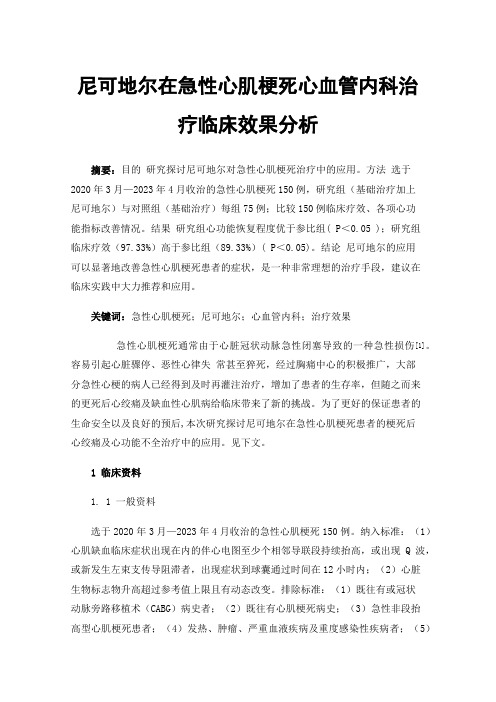
尼可地尔在急性心肌梗死心血管内科治疗临床效果分析摘要:目的研究探讨尼可地尔对急性心肌梗死治疗中的应用。
方法选于2020年3月—2023年4月收治的急性心肌梗死150例,研究组(基础治疗加上尼可地尔)与对照组(基础治疗)每组75例;比较150例临床疗效、各项心功能指标改善情况。
结果研究组心功能恢复程度优于参比组( P<0.05 );研究组临床疗效(97.33%)高于参比组(89.33%)( P<0.05)。
结论尼可地尔的应用可以显著地改善急性心肌梗死患者的症状,是一种非常理想的治疗手段,建议在临床实践中大力推荐和应用。
关键词:急性心肌梗死;尼可地尔;心血管内科;治疗效果急性心肌梗死通常由于心脏冠状动脉急性闭塞导致的一种急性损伤[1]。
容易引起心脏骤停、恶性心律失常甚至猝死,经过胸痛中心的积极推广,大部分急性心梗的病人已经得到及时再灌注治疗,增加了患者的生存率,但随之而来的更死后心绞痛及缺血性心肌病给临床带来了新的挑战。
为了更好的保证患者的生命安全以及良好的预后,本次研究探讨尼可地尔在急性心肌梗死患者的梗死后心绞痛及心功能不全治疗中的应用。
见下文。
1 临床资料1. 1 一般资料选于2020年3月—2023年4月收治的急性心肌梗死150例。
纳入标准:(1)心肌缺血临床症状出现在内的伴心电图至少个相邻导联段持续抬高,或出现Q波,或新发生左束支传导阻滞者,出现症状到球囊通过时间在12小时内;(2)心脏生物标志物升高超过参考值上限且有动态改变。
排除标准:(1)既往有或冠状动脉旁路移植术(CABG)病史者;(2)既往有心肌梗死病史;(3)急性非段抬高型心肌梗死患者;(4)发热、肿瘤、严重血液疾病及重度感染性疾病者;(5)严重的肝肾功能不全者。
按照患者意愿进行分组,并签署同意书。
研究组与参比组各75例。
在对照组中,男40例、女35例,年纪43-75岁;研究组,男39例,女36例,年纪45-78岁,平均年龄(61.50±5.54)岁。
尼可地尔治疗顽固性心绞痛的临床效果分析
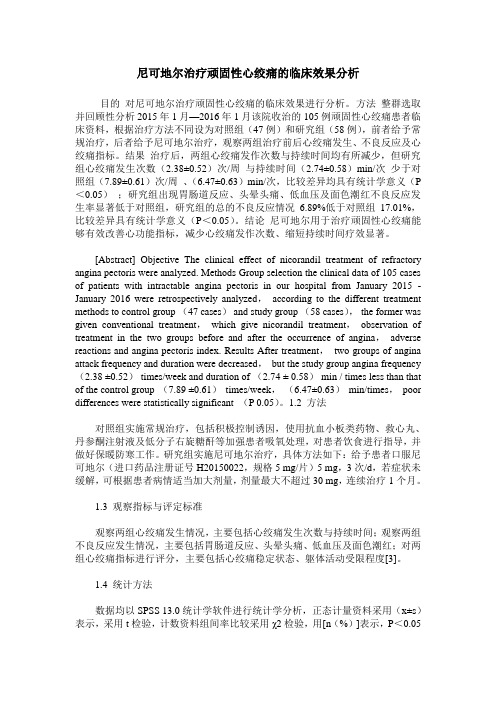
尼可地尔治疗顽固性心绞痛的临床效果分析目的对尼可地尔治疗顽固性心绞痛的临床效果进行分析。
方法整群选取并回顾性分析2015年1月—2016年1月该院收治的105例顽固性心绞痛患者临床资料,根据治疗方法不同设为对照组(47例)和研究组(58例),前者给予常规治疗,后者给予尼可地尔治疗,观察两组治疗前后心绞痛发生、不良反应及心绞痛指标。
结果治疗后,两组心绞痛发作次数与持续时间均有所减少,但研究组心绞痛发生次数(2.38±0.52)次/周与持续时间(2.74±0.58)min/次少于对照组(7.89±0.61)次/周、(6.47±0.63)min/次,比较差异均具有统计学意义(P <0.05);研究组出现胃肠道反应、头晕头痛、低血压及面色潮红不良反应发生率显著低于对照组,研究组的总的不良反应情况6.89%低于对照组17.01%,比较差异具有统计学意义(P<0.05)。
结论尼可地尔用于治疗顽固性心绞痛能够有效改善心功能指标,减少心绞痛发作次数、缩短持续时间疗效显著。
[Abstract] Objective The clinical effect of nicorandil treatment of refractory angina pectoris were analyzed. Methods Group selection the clinical data of 105 cases of patients with intractable angina pectoris in our hospital from January 2015 - January 2016 were retrospectively analyzed,according to the different treatment methods to control group (47 cases)and study group (58 cases),the former was given conventional treatment,which give nicorandil treatment,observation of treatment in the two groups before and after the occurrence of angina,adverse reactions and angina pectoris index. Results After treatment,two groups of angina attack frequency and duration were decreased,but the study group angina frequency (2.38 ±0.52)times/week and duration of (2.74 ± 0.58)min / times less than that of the control group (7.89 ±0.61)times/week,(6.47±0.63)min/times,poor differences were statistically significant (P 0.05)。
静脉注射尼可地尔联合常规治疗对急性心力衰竭的疗效及安全性
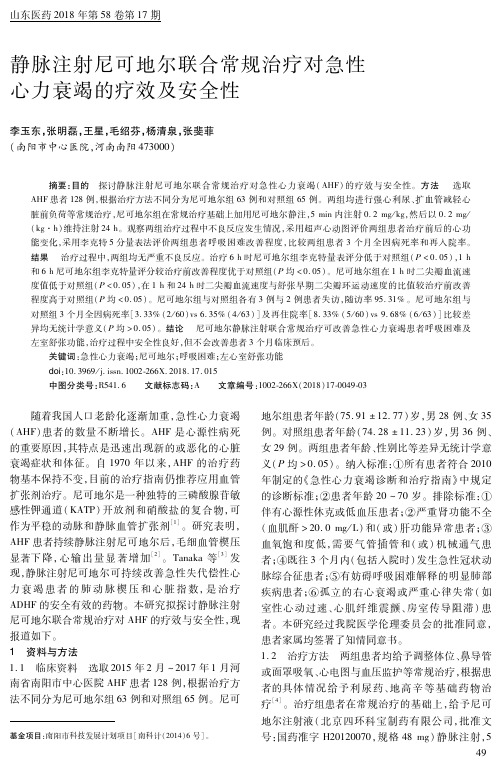
随着我国人口老龄化逐渐加重,急性心力衰竭 (AHF)患 者 的 数 量 不 断 增 长。 AHF是 心 源 性 病 死 的重要原因,其特点是迅速出现新的或恶化的心脏 衰竭症状和体征。自 1970年以来,AHF的治疗药 物基本保持不变,目前的治疗指南仍推荐应用血管 扩张剂治疗。尼可地尔是一种独特的三磷酸腺苷敏 感性钾通 道 (KATP)开 放 剂 和 硝 酸 盐 的 复 合 物,可 作为平稳的动脉和静脉血管扩张剂[1]。研究表明, AHF患者持续静脉注射尼可地尔后,毛细血管楔压 显著下 降,心 输 出 量 显 著 增 加[2]。Tanaka等[3]发 现,静脉注射尼可地尔可持续改善急性失代偿性心 力 衰 竭 患 者 的 肺 动 脉 楔 压 和 心 脏 指 数,是 治 疗 ADHF的安全有效的药物。本研究拟探讨静脉注射 尼可地尔联合常规治疗对 AHF的疗效与安全性,现 报道如下。 1 资料与方法 1.1 临床资料 选取 2015年 2月 ~2017年 1月河 南省南阳市中心医院 AHF患者 128例,根据治疗方 法不同分为尼可地尔组 63例和对照组 65例。尼可
24h,由我院超声科资深医师对患者进行超声心动 特量表评分低于对照组,差异有统计学意义 (P<
图检查,患者半坐位行经胸壁超声心动图 (型号: 0.05)。1h和 6h尼可地尔组李克特量评分较治疗
EUB7500,日本日立医疗有限公司)检查。采用频 前改善程度显著优于对照组,差异均有统计学意义
谱多普勒在心尖四腔心切面二尖瓣口测量二尖瓣血 流速度(E),采用组织多普勒成像在心尖四腔心切 面测量舒张早期二尖瓣环运动速度 (e′)。计算 E 及 e′的比值(E/e′)以评价患者左室舒张功能[5,6]。 1.4 呼吸困难评价 患者呈坐位(45°~60°),在基 线、治疗后 1h、6h和 24h,采用李克特 5分量表法
注射用前列地尔说明书--保达新

注射用前列地尔说明书【药品名称】通用名:注射用前列地尔商品名:保达新英文名:Alprostadil for Injection汉语拼音:Zhusheyong Qianliedi'er【成份】1.化学名称为:(1R,2R,3R)-3-羟基2-((E)-(3S)-3-羟基-1-辛烯基]-5-氧代环戊烷庚酸其结构式为:分子式:C20H34O5分子量:354.49CAS No.:745-65-32. 辅料:α-环糊精和注射用乳糖。
【性状】本品为白色冻干制剂,有引湿性,无嗅。
冻干制剂溶解后为澄清溶液。
【适应症】用于治疗第III、第IV期慢性阻塞性动脉疾病(Fontaine分类)。
【规格】每安瓿冻干品含前列地尔-α-环糊精包合物666.7μg,其中前列地尔20μg。
【用法用量】剂量静脉注射:根据目前的资料,除非另有说明,下列剂量方案适合于本品静脉注射:将2安瓿本品(40μg前列地尔)溶于50-250ml生理盐水中,将此溶液作静脉滴注,2小时滴完,每日2次。
或将3安瓿本品(60μg前列地尔)溶于50-250ml生理盐水中进行静脉滴注,3小时滴完,每日1次。
对于肾功能损害的病人(肾功能不全,肌酐值>1.5mg/dl),静脉滴注治疗应从1安瓿本品开始,滴注时间为2小时,每日2次(40μg前列地尔)。
根据临床总体情况,在2至3天内将剂量增加至上述推荐的正常剂量。
肾功能不全或有心脏病的病人其滴注液体量应限制在50-100ml/天,并且宜用输液泵滴注。
动脉内注射:将1安瓿本品(相当于20μg前列地尔)溶于50ml生理盐水。
基于目前的资料,下列剂量方案适合于动脉内输注治疗:除非另有说明,半安瓿本品(10μg前列地尔)由输液泵于60-120分钟内经动脉输完。
如有必要,特别是如果存在坏死,只要可以耐受,剂量可增加至1安瓿(20μg前列地尔)。
通常每天输注1次。
如动脉内输注是通过一个导管给予,根据耐受性和症状的严重程度,建议剂量为0.1-0.6ng/kg体重/分钟,用输液泵输注12小时以上。
尼可地尔片说明书

尼可地尔片说明书尼可地尔片(喜格迈)用于冠心病,心绞痛的治疗。
下面是店铺整理的尼可地尔片说明书,欢迎阅读。
尼可地尔片商品介绍通用名:尼可地尔片生产厂家: Chugai Pharmaceutical Co., Ltd.(日本)批准文号:H20110491药品规格:5mg*420片药品价格:¥252元尼可地尔片说明书【通用名称】尼可地尔片【商品名称】喜格迈(尼可地尔片)【英文名称】Nicorandiltablets【拼音全码】XiGeMai(NiKeDiErPian)【主要成份】喜格迈(尼可地尔片)主要成份为尼可地尔,化学名称为:乙-烟酰胺基硝酸乙酯【性状】喜格迈(尼可地尔片)为白色或类白色片。
【适应症/功能主治】用于冠心病,心绞痛的治疗。
【规格型号】5mg*420s【用法用量】通常,成人1次5mg,1日3次。
根据症状轻重可适当增减。
【不良反应】1.常见有头痛、头晕、耳鸣、失眠等反应,服用阿司匹林可减轻症状,否则应停药;出现皮疹等过敏反应时应停药。
2.胃肠症状:腹痛、腹泻、食欲不振、消化不良、恶心、呕吐、便秘等,偶见口角炎,可有氨基转移酶升高。
3.心血管系统:心悸、乏力、颜面潮红、下肢浮肿,还可引起反射性心率加快,严重低血压等反应。
【禁忌】1.青光眼患者禁用。
2.严重肝、肾疾病患者禁用。
【注意事项】以下患者需慎用:重症肝功能障碍的患者【服用本药剂时有可能出现肝功能检查值的异常】;青光眼患者【有可能导致眼内压上升】;高龄患者【请参照“老年用药”】。
重要的基本注意事项:在服用本制剂初期,与服用硝酸酯、亚硝酸酯类药物相似可能会由于血管扩张作用而引起搏动性头痛,当出现这种情况时,要采取减量或中止给药等适当的处置。
因本制剂同具有磷酸二酯酶5阻断作用的勃起障碍治疗剂(枸橼酸西地那非、盐酸伐地那非水合物、他达拉非)并用能使降压作用增强,而导致血压过度下降,所以在服用本制剂前,应充分确认没有服用该类药物。
此外,在服用本制剂期间及服用本制剂后,还应充分注意不要服用该类药物。
尼可地尔注射液对急性心肌梗死患者短期预后的影响

尼可地尔注射液对急性心肌梗死患者短期预后的影响[摘要]目的:探讨尼可地尔注射液对急性心肌梗死患者短期预后的影响。
方法:选择2021年7月至2022年7月我院急性心肌梗死患者120例为研究对象,依据随机数字表法分为对照组和实验组,每组各60例。
对照组予以常规治疗,实验组在对照组的基础上予以尼可地尔注射液治疗。
比较两组患者心肌酶指标、脑利钠肽前体、彩超结构数值以及住院期间及出院1年内心血管事件发生率。
结果:实验组LDH、CK低于对照组(P<0.05),实验组NT-proBNP、LVEF高于对照组(P<0.05)。
实验组住院期间及出院1年内心血管事件总发生率3.33%低于对照组13.33%(P<0.05)。
结论:尼可地尔注射液对急性心肌梗死患者短期预后的影响具有积极意义,改善患者心肌酶指标、脑利钠肽前体、彩超结构数值,降低心血管事件发生率,值得推广。
关键词:尼可地尔注射液;急性心肌梗死;心肌酶指标;心血管事件发生率急性心肌梗死是一种发病紧急、进展速度较快的心血管疾病,是由冠状动脉病变,造成血管供给不及时,使相应的心肌严重而持久的急性缺血导致心肌坏死的一种疾病,常可发生心力衰竭,心源性休克或心律失常等不良并发症。
对此,需在临床上采取一种积极有效的药物治疗是至关重要的[1-2]。
本研究选择2021年7月至2022年7月我院急性心肌梗死患者120例为研究对象,探讨尼可地尔注射液对急性心肌梗死患者短期预后的影响。
现报道如下:1.1一般资料选择2021年7月至2022年7月我院急性心肌梗死患者120例为研究对象,依据随机数字表法分为对照组和实验组,每组各60例。
对照组男30例,女30例,年龄(62-90)岁,平均年龄(76.04±3.19)岁。
实验组男32例,女28例,年龄(60-90)岁,平均年龄(75.53±3.21)岁。
两组基线资料比较差异无统计学意义(P>0.05),具有可比性。
1.2方法对照组:常规治疗。
尼可地尔与替罗非班治疗急性冠脉综合征患者经皮冠状动脉介入术后无复流的临床疗效对比研究
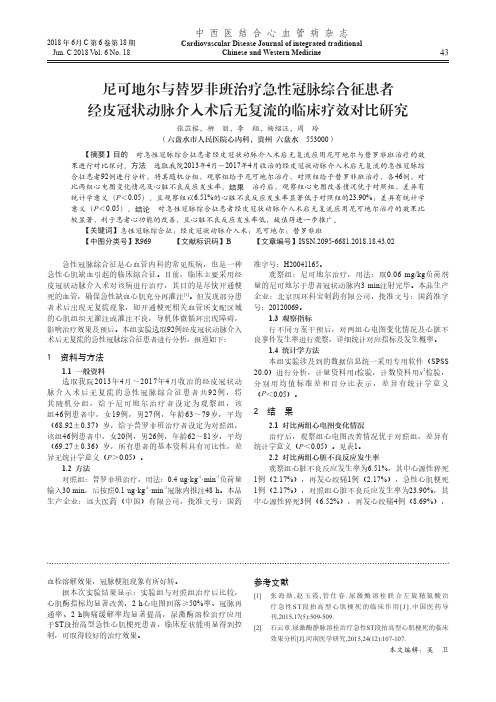
43中西医结合心血管病杂志Cardiovascular Disease Journal of integrated traditionalChinese and Western Medicine2018 年 6月 C 第 6 卷第 18 期Jun. C 2018 V ol. 6 No. 18血栓溶解效果,冠脉梗阻现象有所好转。
据本次实验结果显示:实验组与对照组治疗后比较,心肌酶指标均显著改善,2 h 心电图回落≥50%率、冠脉再通率、2 h 胸痛缓解率均显著提高,尿激酶溶栓治疗应用于ST 段抬高型急性心肌梗死患者,临床症状能明显得到控制,可取得较好的治疗效果。
参考文献[1]张海勋,赵玉霞,管仕春.尿激酶溶栓联合左旋精氨酸治疗急性S T 段抬高型心肌梗死的临床作用[J ].中国医药导刊,2015,17(5):509-509.[2]石云章.尿激酶静脉溶栓治疗急性ST 段抬高型心肌梗死的临床效果分析[J].河南医学研究,2015,24(12):107-107.本文编辑:吴 卫尼可地尔与替罗非班治疗急性冠脉综合征患者经皮冠状动脉介入术后无复流的临床疗效对比研究张苡榕,柳 丽,李 翔,杨绍汪,周 玲(六盘水市人民医院心内科,贵州 六盘水 553000)【摘要】目的 对急性冠脉综合征患者经皮冠状动脉介入术后无复流应用尼可地尔与替罗非班治疗的效果进行对比探讨。
方法 选取我院2013年4月~2017年4月收治的经皮冠状动脉介入术后无复流的急性冠脉综合征患者92例进行分析,将其随机分组,观察组给予尼可地尔治疗,对照组给予替罗非班治疗,各46例,对比两组心电图变化情况及心脏不良反应发生率。
结果 治疗后,观察组心电图改善情况优于对照组,差异有统计学意义(P <0.05)。
且观察组以6.51%的心脏不良反应发生率显著低于对照组的23.90%;差异有统计学意义(P <0.05)。
结论 对急性冠脉综合征患者经皮冠状动脉介入术后无复流应用尼可地尔治疗的效果比较显著,利于患者心功能的改善,且心脏不良反应发生率低,故值得进一步推广。
2012尼可地尔.说明书
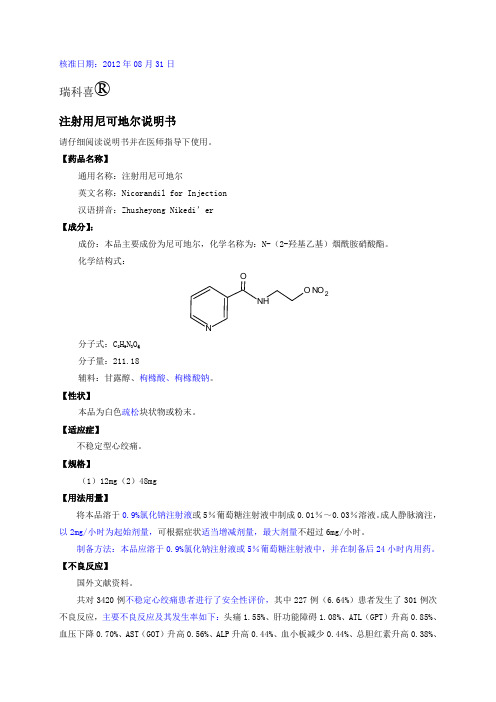
核准日期:2012年08月31日瑞科喜®注射用尼可地尔说明书请仔细阅读说明书并在医师指导下使用。
【药品名称】通用名称:注射用尼可地尔英文名称:Nicorandil for Injection汉语拼音:Zhusheyong Nikedi’er【成分】:成份:本品主要成份为尼可地尔,化学名称为:N-(2-羟基乙基)烟酰胺硝酸酯。
化学结构式:ONO2N NHO分子式:C8H9N3O4分子量:211.18辅料:甘露醇、枸橼酸、枸橼酸钠。
【性状】本品为白色疏松块状物或粉末。
【适应症】不稳定型心绞痛。
【规格】(1)12mg(2)48mg【用法用量】将本品溶于0.9%氯化钠注射液或5%葡萄糖注射液中制成0.01%~0.03%溶液。
成人静脉滴注,以2mg/小时为起始剂量,可根据症状适当增减剂量,最大剂量不超过6mg/小时。
制备方法:本品应溶于0.9%氯化钠注射液或5%葡萄糖注射液中,并在制备后24小时内用药。
【不良反应】国外文献资料。
共对3420例不稳定心绞痛患者进行了安全性评价,其中227例(6.64%)患者发生了301例次不良反应,主要不良反应及其发生率如下:头痛1.55%、肝功能障碍1.08%、ATL(GPT)升高0.85%、血压下降0.70%、AST(GOT)升高0.56%、ALP升高0.44%、血小板减少0.44%、总胆红素升高0.38%、LDH升高0.26%、贫血0.26%、γ-GTP升高0.23%等(再审查结束时)。
共对193例急性心功能不全(包括慢性心功能不全的急性发作)患者进行了安全性评价,其中50例(25.9%)患者发生了79例次不良反应,主要不良反应及其发生率如下:血小板减少5.7%、头痛5.2%、血压下降3.6%、总胆红素升高3.6%、血清总蛋白减少2.6%、AST(GOT)升高1.6%、ATL (GPT)升高1.6%、血肌酐升高1.6%、白细胞增加1.6%、尿蛋白阳性1.6%、LDH升高1.0%、CK(CPK)升高1.0%、室性心动过速1.0%、血钾升高1.0%、HDL胆固醇减少1.0%等(批准时)。
尼可地尔联合前列地尔注射液治疗顽固性心绞痛的疗效分析
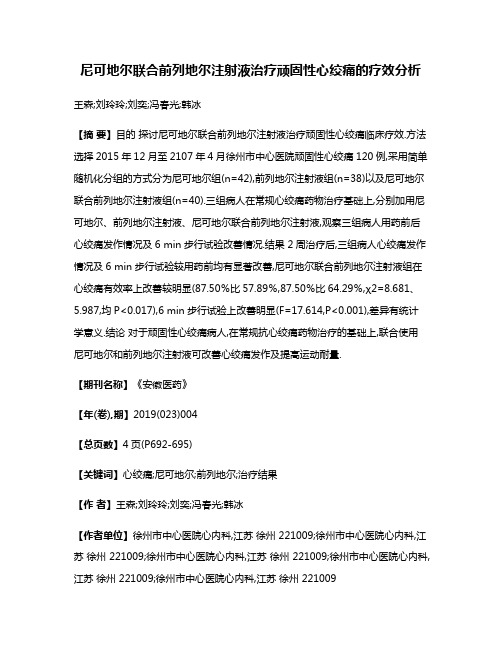
尼可地尔联合前列地尔注射液治疗顽固性心绞痛的疗效分析王森;刘玲玲;刘奕;冯春光;韩冰【摘要】目的探讨尼可地尔联合前列地尔注射液治疗顽固性心绞痛临床疗效.方法选择2015年12月至2107年4月徐州市中心医院顽固性心绞痛120例,采用简单随机化分组的方式分为尼可地尔组(n=42),前列地尔注射液组(n=38)以及尼可地尔联合前列地尔注射液组(n=40).三组病人在常规心绞痛药物治疗基础上,分别加用尼可地尔、前列地尔注射液、尼可地尔联合前列地尔注射液,观察三组病人用药前后心绞痛发作情况及6 min步行试验改善情况.结果 2周治疗后,三组病人心绞痛发作情况及6 min步行试验较用药前均有显著改善,尼可地尔联合前列地尔注射液组在心绞痛有效率上改善较明显(87.50%比57.89%,87.50%比64.29%,χ2=8.681、5.987,均P<0.017),6 min步行试验上改善明显(F=17.614,P<0.001),差异有统计学意义.结论对于顽固性心绞痛病人,在常规抗心绞痛药物治疗的基础上,联合使用尼可地尔和前列地尔注射液可改善心绞痛发作及提高运动耐量.【期刊名称】《安徽医药》【年(卷),期】2019(023)004【总页数】4页(P692-695)【关键词】心绞痛;尼可地尔;前列地尔;治疗结果【作者】王森;刘玲玲;刘奕;冯春光;韩冰【作者单位】徐州市中心医院心内科,江苏徐州 221009;徐州市中心医院心内科,江苏徐州 221009;徐州市中心医院心内科,江苏徐州 221009;徐州市中心医院心内科,江苏徐州 221009;徐州市中心医院心内科,江苏徐州 221009【正文语种】中文随着人口老龄化、生活水平的提高、生活环境以及生活习惯的改变,冠心病(CHD)的发病率和致死率近年逐步增加,严重影响了人民的生活质量以及生命安全,成为最常见的心血管疾病。
随着医疗技术及手段发展,心脏冠脉CTA 和冠脉造影术的发展,心脏冠状动脉病变部位及严重程度得以明确。
- 1、下载文档前请自行甄别文档内容的完整性,平台不提供额外的编辑、内容补充、找答案等附加服务。
- 2、"仅部分预览"的文档,不可在线预览部分如存在完整性等问题,可反馈申请退款(可完整预览的文档不适用该条件!)。
- 3、如文档侵犯您的权益,请联系客服反馈,我们会尽快为您处理(人工客服工作时间:9:00-18:30)。
Revised: March 2010 (10th version)- DRUG FOR TREATMENT OF UNSTABLE ANGINA PECTORIS AND ACUTE HEART FAILURE -SIGMART®Injection 2 mgSIGMART®Injection 12 mgSIGMART®Injection 48 mgINDICATIONSUnstable angina pectorisAcute heart failure (including acute decompensation of chronic heart failure)DOSAGE AND ADMINISTRATIONUnstable angina pectorisSIGMART is dissolved in isotonic sodium chloride solution or 5% glucose injection to prepare a 0.01%-0.03% solution. The usual adult dosage for intravenous drip infusion is 2 mg of nicorandil per hour. The dosage may be adjusted according to symptoms, while not exceeding 6 mg per hour. Acute heart failure (including acute decompensation of chronic heart failure)SIGMART is dissolved in isotonic sodium chloride solution or 5% glucose injection to prepare a 0.04%-0.25% solution. The usual adult dosage is 0.2 mg/kg of nicorandil to be given by intravenous administration over about 5 minutes, followed by 0.2 mg/kg/hr of nicorandil to be given by continuous intravenous infusion. The dosage may be adjusted in the range of 0.05-0.2 mg/kg/hr according to changes in blood pressure and symptoms.PRECAUTIONS1. Careful Administration (SIGMART Injection should beadministered with care in the following patients.)(1) Elderly (see 4, "Use in the Elderly".)(2) Patients with hypotension (Since SIGMART lowersblood pressure, this symptom may be exacerbated.)(3) Patients with hepatic or renal dysfunction (Sincemetabolic and excretory functions are impaired, theblood concentration of SIGMART may become high).(4) Patients with left ventricular outflow stenosis,hypertrophic obstructive cardiomyopathy, or aorticstenosis due to acute heart failure (Difference inpressure may be increased and lead to aggravation ofsymptoms.)2. Important Precautions(1) While SIGMART is being administered, blood pressureand hemodynamics should be monitored frequently.Dosage should be adjusted gradually according topatient's hemodynamics and symptoms.(2) When abnormalities such as hypotension are observedwhile SIGMART is being administered or whenpatients may suffer from hypotension, dosage should bereduced or administration discontinued. If necessary,appropriate measures such as elevation of lowerextremities or administration of vasopressors(catecholamine preparations) should be taken.(3) Since coadministration with drugs withPDE5-inhibiting effect(sildenafil citrate, vardenafilhydrochloride hydrate, or tadalafil) may enhance thehypotensive effect of SIGMART and excessivelydecrease blood pressure, confirmation should be madebefore administering SIGMART that these drugs arenot being used. Moreover, the patient should becautioned against using these drugs during or aftertaking SIGMART.(4) When used in patients with acute heart failure,SIGMART should be administered with sufficientmanagement of the patient’s general conditionincluding blood pressure, heart rate, urinary output,body fluids and electrolytes, as well as pulmonaryarterial wedge pressure, cardiac output and blood gasesif possible.(5) When used in patients with acute heart failure,SIGMART may cause a serious decrease in bloodpressure. Therefore, blood pressure should befrequently measured during treatment with SIGMART.If any abnormality is observed, treatment should bediscontinued and appropriate measures taken.(6) If expected improvement is not achieved followingtreatment with SIGMART in patients with acute heartfailure, appropriate measures such as change oftreatment to another should be taken.(7) In patients with acute heart failure, if hemodynamicsand clinical symptoms improve and the patient’scondition becomes stabilized (recover from the acutestage) following treatment with SIGMART, treatmentshould be switched to another. SIGMART has rarelybeen used for more than 48 hours in patients with acuteheart failure. Therefore, if it is necessary to useSIGMART for more than 48 hours, the drug should beadministered with sufficient management of thepatient’s blood circulation and general condition.3. Drug InteractionsContraindications for coadministration (SIGMART4. Adverse ReactionsUnstable angina pectorisThe following adverse reactions to this drug were reported in 227 patients (6.64%) and 301 events of 3,420 patients analyzable for safety. The major adverse reactions were headache (53 events, 1.55%), hepatic function disorder (37 events, 1.08%), increased ALT (GPT) (29 events, 0.85%), decreased blood pressure (24 events, 0.70%), increased AST (GOT) (19 events, 0.56%), increased Al-P (15 events,0.44%), thrombocytopenia (15 events, 0.44%), increased total bilirubin (13 events, 0.38%), increased LDH (9 events, 0.26%), anemia (9 events, 0.26%), and increased γ-GTP (8 events, 0.23%) (at the end of the reexamination period). Acute heart failure (including acute decompensation of chronic heart failure)The following adverse reactions to this drug were reported in 50 of 193 patients (25.9%, 79 events), who were the subjects of safety analysis. The main adverse reactions were throm-bocytopenia (11 events, 5.7%), headache (10 events, 5.2%), decreased blood pressure (7 events, 3.6%), increased total bilirubin (7 events, 3.6%), decreased serum total protein (5 events, 2.6%), increased AST (GOT) (3 events, 1.6%), increased ALT (GPT) (3 events, 1.6%), increased blood creatinine (3 events, 1.6%), leucocytosis (3 events, 1.6%), urinary protein positive (3 events, 1.6%), increased LDH (2 events, 1.0%), increased CK (CPK) (2 events, 1.0%), ventricular tachycardia (2 events, 1.0%), increased blood potassium (2 events, 1.0%) and decreased HDL cholesterol (2 events, 1.0%) (at the time of approval).(1) Clinically Significant Adverse Reactions1) Hepatic dysfunction and jaundice (incidence unknown):Jaundice may develop. Hepatic dysfunction, with in-creased AST (GOT), ALT (GPT) and γ-GTP may occur.Patients should be carefully monitored, and administra-tion of the drug should be discontinued and appropriatetherapeutic measures taken, if suchabnormalities are observed.2) Thrombocytopenia (incidence unknown): Thrombocy-topenia may occur. If any abnormalities are observed,the drug should be discontinued immediately and ap-propriate therapeutic measures must be taken.(2) Other adverse reactionsIf any of the following adverse reactions are observed,appropriate measures such as dosage reduction orNote 4)In the event of such symptom, administration should be discontinued.5. Use in the ElderlySince the elderly often have reduced physiological function and are more likely to experience adverse reactions,SIGMART should be administered while closely andfrequently monitoring blood pressure and hemodynamics.The dosage should be carefully and gradually adjusted inview of the patient’s hemodynamics and symptoms. (See"Important Precautions".)In particular, caution should be taken for decrease in blood pressure, which is apt to occur in elderly patients with acute heart failure.6. Use during Pregnancy, Delivery or LactationSince the safety of SIGMART in pregnant women has not been established, use of SIGMART in pregnant women or women who may possibly be pregnant is not recommended.7. Pediatric UseThe safety of SIGMART in children has not beenestablished (no clinical experience).8. Precautions concerning UsePreparation methodSIGMART should be dissolved in physiological saline or 5% glucose solution for injection and used within 24 hours of preparation.PHARMACOKINETICS1. Blood concentration(1) Single administration1)To five healthy volunteers, 2 mg of SIGMART Injectionwas administered once over a two minute period Note 5).administrationNote 5) This is different from the approved dosage andadministration of SIGMART. (See "DOSAGE AND ADMINISTRATION”.)(2) Continuous administration 2), 3)To five healthy volunteers, SIGMART Injection was intravenously administered for six hours continuously Note 6)6h completion of continuous intravenous administration(3) Long-term administration (in patients with acute heartfailure) 4)SIGMART Injection was intravenously administered to 14 patients with acute heart failure at a dose of 0.2 mg/kg for 5 minutes, and then at a rate of 0.2 mg/kg/hr for 48 hours continuously. The time course of plasma nicorandil concentration is shown below.Time after the start of administration (hr)Time course of plasma nicorandil concentration in patients with acute heart failure (mean±SE)2. Metabolism and excretion 3), 5)The metabolism and excretion of SIGMART wereinvestigated by intravenously administering 2, 4 or 6 mg/hr of SIGMART Injection (as nicorandil) to five healthy men Note 6)and 6 mg/hr of nicorandil labelled with deuterium to four healthy men for six hours, respectively. Most nicorandil was subjected to a denitration reaction and metabolized to N-(2-hydroxy ethyl) nicotinamide. This metabolite, N-(2-hydroxy ethyl) nicotinamide, wasdetectable in the plasma 0.25-0.5 hours after the start of continuous intravenous administration, and reached aplateau 3 to 9 hours after administration. The cumulative urinary excretion of nicorandil and the metabolite [N-(2-hydroxy ethyl) nicotinamide] 24 hours after administration was 0.2% to 0.4% and 2% to 5%, respectively.Note 6) This is different from the approved dosage andadministration of SIGMART for acute heart failure (including acute decompensation of chronic heart failure).(See "DOSAGE AND ADMINISTRATION".)3. Serum protein binding rate 6)In an in vitro test using human serum, the serum protein binding rate ranged from 34.2% to 41.5% (nicorandil concentration: 1-100 µg/mL)CLINICAL STUDIES1. The usefulness of SIGMART Injection was confirmed by a double-blind comparative study on patients with unstableangina pectoris 7).2. In clinical studies including double-blind study on patients with unstable angina pectoris, overall improvement rates ranged from 68.4% to 75.0%7, 8) in a total of 134 assessable patients.3. In clinical studies including a double-blind study of patients with acute heart failure (including acute decompensation of chronic heart failure, with a pulmonary arterial wedge pressure of 18 mmHg or more), SIGMART Injection was intravenously administered to 54 patients at a dose of 0.2 mg/kg for 5 minutes, and then at a rate of 0.2 mg/kg/hr continuously. As a result, their pulmonary arterial wedge pressure decreased by 21.2%9-11).PHARMACOLOGY1. Pharmacological action(1) Coronary vasodilating activity1) In a canine Langendorff preparation, nicorandil dilated relatively small coronary arteries under normal-pressure perfusion, whereas underlow-pressure perfusion during ischemia, it dilated large coronary arteries. In unanesthetized dogs, intravenous administration of nicorandil dilated large coronary arteries in a dose-dependent manner irrespective of coronary blood flow 12, 13). 2) When SIGMART Injection (2 mg to 6 mg or 0.05-0.1 mg/kg of nicorandil) was administered intravenously once to patients with coronary artery disease Note 7), coronary angiography showed02004006008001000120014001600012243648Time after the start of administration (hr)Time course of plasma nicorandil concentration (mean±SE)Continuous i.v. administrationP l a s m a c o n c e n t r a t i o n (n g /m L )P l a s m a c o n c e n t r a t i o n (n g /m L )significant coronary vasodilation in a dose-dependentmanner. The rate of dilation (in relation to theinternal diameter of non-stenotic vessels) ranged from108% to 127%14-16).(2) Effects on coronary blood flow1) Nicorandil produced a dose-dependent, sustainedincrease in coronary blood flow following intravenousor intraduodenal administration in open-chestedanesthetized dogs. The same responses were shownin conscious dogs, isolated canine heart-lungpreparations, and canine Langendorff'spreparations13,17-20).2) SIGMART Injection (0.1 mg/kg of nicorandil) wasadministered intravenously once Note 7) to patients withangina pectoris having no significant stenosis or anorganic stenosis of 75% or greater in the left coronaryartery and to people with no significant stenosis.The great cardiac vein flow was then measured threeto five minutes after administration (continuousthermal dilution method). In the non-stenosis group(n=5), the average volume increased from 115 to 187mL/min., and in the stenosis group (n=4), it increasedfrom 38 to 69 mL/min., thus confirming significantincreases in coronary blood flow16).(3) Coronary vasospasmolytic activity1) In dogs with partially constricted coronary arteries,nicorandil inhibited cyclical reductions of coronaryblood flow and ST elevations in ECG. Coronaryvasoconstriction induced by the intracoronaryinjection of methacholine or norepinephrine inminiature pigs was also suppressed by nicorandil21,22).2) In 10 patients with coronary spastic angina pectoris,0.1 mg/kg of nicorandil was administeredintravenously to treat coronary spasms induced byergonovine load test or naturally occuring coronaryspasms Note 7). The results showed that nicorandilattenuated coronary spasms 23).(4) Effects on cardio-hemodynamics1) Nicorandil slightly decreased systemic blood pressuredose-dependently when injected intravenously inopen chest dogs under general anesthesia. Therewere no appreciable effects on heart rate, myocardialcontractility, myocardial oxygen consumption andatrioventricular conduction time at doses causing asignificant decrease in coronary vascular resistance17,18, 24).2) When SIGMART Injection (2 to 6 mg or0.05-0.1 mg/kg of nicorandil) was administeredintravenously once to patients with coronary anginapectoris at rest Note 7), heart rate increased, and BPdynamics index (e.g., systolic aortic pressure),systemic vascular resistance, and pressure-rateproduct decreased in a dose-dependent manner.However, the range of these fluctuations were slightto mild14-16). While right intraventricular pacing wasutilized, SIGMART Injection (0.05mg/kg ofnicorandil) was administered intravenously once Note7)to eight patients with angina pectoris with 75% orgreater stenosis. In terms of left ventricular function,nicorandil suppressed increases in the left ventricularend-diastolic pressure and increased the cardiacindex25).Note 7) This is different from the approved dosageand administration of SIGMART. (See"DOSAGE AND ADMINISTRATION”.) (5) Effects on heart failure1) In a canine model of acute heart failure, treatment withnicorandil decreased right atrial pressure and leftventricular pressure in the late diastolic phase (adecrease in the preload), with a concurrent decrease inthe total peripheral vascular resistance (a decrease inthe afterload). Consequently, by improving the leftventricular contractility and increasing the cardiacoutput, the treatment improved the hemodynamics inheart failure26).2) Patients with acute heart failure (including acutedecompensation of chronic heart failure) receivedintravenous administration of SIGMART at a dose of0.2 mg/kg/5 min followed by a 2-hour continuousintravenous infusion at a rate of 0.2 mg/kg/hr. As aresult, a significant decrease was found in thepulmonary arterial wedge pressure, diastolic pressure,systolic pulmonary arterial pressure, diastolicpulmonary arterial pressure, and total peripheralvascular resistance, while a significant increase wasseen in the cardiac index, cardiac output, output perstroke, and output index per stroke. No significantchange was found in the heart rate, systolic bloodpressure, mean right atrial pressure, or pressure-rateProduct11).3) In patients with congestive heart failure who receiveda long-term continuous intravenous infusion ofSIGMART, a decrease in the pulmonary arterialwedge pressure was maintained, which suggested thatdrug resistance would hardly occur27).2. Vasodilating effect and its mechanismThe vasohypotonic effect of nicorandil on extracted blood vessels is suppressed by ATP-sensitive K channel inhibitors or guanylate cyclase inhibitors28). Moreover, in a caninemodel of acute heart failure, the cardiachemodynamics-improving effect of the drug (e.g. effect of increasing the aortic blood flow) was suppressed byATP-sensitive K channel inhibitors29). Furthermore, the drug caused an increase in the cGMP content in extracted blood vessels30). These facts suggest that the vasodilating effect of the drug is related to the effect of opening the ATP-sensitive K channel, as well as to the effect of increasing production of cGMP.PHYSICOCHEMISTRYNonproprietary name:Nicorandil (JAN)Chemical name:N-[2-(Nitrooxy) ethyl] pyridine-3-carboxamide Structural formula:Molecular formula: C 8H 9N 3O 4Molecular weight: 211.17 Description:Nicorandil occurs as white crystals.It is freely soluble in methanol, ethanol (99.5), acetic acid (100); soluble in acetic anhydride; sparingly soluble in water.Melting point:About 92° C (to be decomposed)PACKAGING2 mg InjectionBoxes of 10 vials. 12 mg InjectionBoxes of 10 vials. 48 mg InjectionBoxes of 10 vials.REFERENCES1) Azuma J. et. al.: Yakuri To Chiryo (Jpn. Pharmacol. & Ther.), 15 (11), 4779, 19872) Azuma J. et. al.: Yakuri To Chiryo (Jpn. Pharmacol. & Ther.), 18 (9), 3479, 19903) Internal document: Azuma J. et al.: Pharmacokinetics following intravenous continuous administration of nicorandil in healthy adults (1990)4) Internal document: Phase III study in patients with acute heart failure (long-term administration)5) Internal document: Ishitani H. et al.: Investigation on urinary metabolites following continuous intravenous administration of nicorandil in healthy adults (1990) 6) Internal document: Ida S. et al.: in vivo and in vitro serum protein binging of nicorandil (1991)7) Kato K. et al.: Rinsho Iyaku (J. of Clinical Ther. & Medicines), 7 (9), 2031, 19918) Kato K. et al.: Rinsho To Kenkyu (Jpn. J. of Clinical and Experi. Medicine), 68 (11), 3480, 19919) Internal document: Early phase II study in patients with acute heart failure (single + continuous administration) 10) Internal document: Late phase II study in patients with acute heart failure11) Internal document: Phase III study in patients with acute heart failure (placebo-controlled)12) Yamada A. et al.: Arzneim. -Forsch. (Drug Res.), 37 (11), 1252, 198713) Nakagawa Y. et al.: Jpn. Heart J., 20 (6), 881, 1979 14) Hata N. et al.: Myakkangaku (Vessels), 31 (4), 333, 199115) Gomyo Y. et al.: Therapeutic Research, 10 (4), 1615, 198916) Motohara S. et al.: Therapeutic Research, 10(4), 1307, 198917) Uchida Y. et al.: Jpn. Heart J., 19 (1), 112, 197818) Satoh K. et al.: Shinzo (Heart), 12 (4), 371, 1980 19) Mizukami M. et al.: Arzneim-Forsch. (Drug Res.), 31 (2), 1244, 198120) Sakanashi M. et al.: Oyo Yakuri (Pharmacotrics), 15 (3), 385, 197821) Uchida Y. et al.: Jpn. Heart J., 19 (6), 904, 197822) Sakai K. et al.: J. Pharmacol. Exp. Ther., 227 (1), 220, 198323) Matsumura Y. et al.: Therapeutic Research, 11 (5), 1448, 199024) Sakai K. et al.: J. Cardiovasc. Pharmacol., 3 (1), 139, 198125) Kambara H. et al.: Am. J. Cardiol., 63, 56J, 1989 26) Kamijo, T. et al.: J. Cardiovasc. Pharmacol., 33: 93 (1999)27) Larsen, A. I. et al.: Am. Heart J., 134: 435 (1997) 28) Internal document: Fukazawa M. et al.:Pharmacological study using extracted blood vessels of rats (2001)29) Kamijo, T. et al.: Asia Pac. J. Pharmacol., 11: 141 (1996)30) Internal document: Imagawa J. et al.: Influence on cAMP and cGMP in aortas of rats (2000)REQUEST FOR LITERATURE SHOULD BE MADE TO:Requests for any of the internal documents listed in the“REFERENCES” section can also be made to the following: Drug Information CenterChugai Pharmaceutical Co., Ltd.1-1 Nihonbashi-Muromachi 2-chome, Chuo-ku, Tokyo 103-8324, Japan TEL: 0120-189706 FAX: 0120-189705http://www.chugai-pharm.co.jpManufactured and Distributed by:Chugai Pharmaceutical Co., Ltd., Roche Group.1-1 Nihonbashi-Muromachi 2-chome, Chuo-ku, Tokyo 103-8324, JapanBRAND NAMES IN OTHER COUNTRIESSigmart Injection (Korea)。
